info@sadi.co.ke
+254727368241
Introduction:
Interior design is an art and science that focuses on enhancing the aesthetics and functionality of interior spaces. It's about creating environments that not only look stunning but also serve the practical needs of the people who inhabit them. In this article, we'll explore the world of interior design, its principles, and how professionals craft spaces that are both functional and beautiful.
1. Balance and Harmony:
A fundamental principle in interior design is achieving balance and harmony within a space. This involves arranging elements like furniture, color, texture, and lighting in a way that creates a pleasing and visually balanced composition.
2. Form and Function:
The primary objective of interior design is to make spaces not just visually appealing but also functional. Interior designers carefully consider the layout, flow, and purpose of each room to ensure it meets the needs of the people using it.
3. Color and Lighting:
Color and lighting play a significant role in interior design. Designers use color theory to select palettes that create the desired mood, while proper lighting enhances the atmosphere and functionality of a space.
4. Furniture and Accessories:
The selection of furniture and accessories is a crucial aspect of interior design. The choices made here influence the comfort, style, and overall functionality of a room.
5. Texture and Patterns:
Textures and patterns add depth and visual interest to a space. Interior designers skillfully combine various textures and patterns to create a rich and inviting environment.
6. Space Planning:
Effective space planning involves optimizing the use of space, ensuring that furniture and layout maximize functionality and comfort. It's about making the most of available square footage.
7. Personalization:
A key element of interior design is personalization. Designers work closely with clients to understand their tastes, preferences, and lifestyle, creating spaces that reflect the personality of the occupants.
8. Environmental Considerations:
Sustainability and eco-conscious design are gaining importance in interior design. Many designers now incorporate environmentally friendly materials and practices to reduce the impact on the environment.
9. Trends and Styles:
Interior design is not static; it evolves with time. Designers stay updated on the latest trends and styles to provide fresh and contemporary solutions to their clients.
10. Mood and Atmosphere:
Interior design has the power to influence the mood and atmosphere of a space. Whether it's creating a cozy living room or an inspiring workspace, designers use their expertise to set the desired tone.
11. Budget and Resources:
Interior designers work within budgets, and they are skilled at finding cost-effective solutions that don't compromise on the quality or aesthetics of the design.
12. Collaboration and Communication:
Effective communication between designers, clients, and contractors is crucial for successful interior design projects. Designers ensure that everyone is on the same page and that the final result meets the client's vision.
13. Time Management:
Interior designers manage project timelines efficiently, ensuring that projects are completed in a timely manner and that clients can enjoy their newly designed spaces as planned.
Conclusion:
Interior design is a multidisciplinary field that requires a deep understanding of aesthetics, functionality, and the needs of the occupants. Skilled interior designers take all of these factors into account when crafting beautiful and functional spaces that enhance the lives of those who use them. Whether it's a cozy home, an inspiring office, or a welcoming commercial space, interior design is about making spaces come to life and creating environments that resonate with the people who live, work, and thrive within them.
 November 06, 2023 - BY Admin
November 06, 2023 - BY Admin